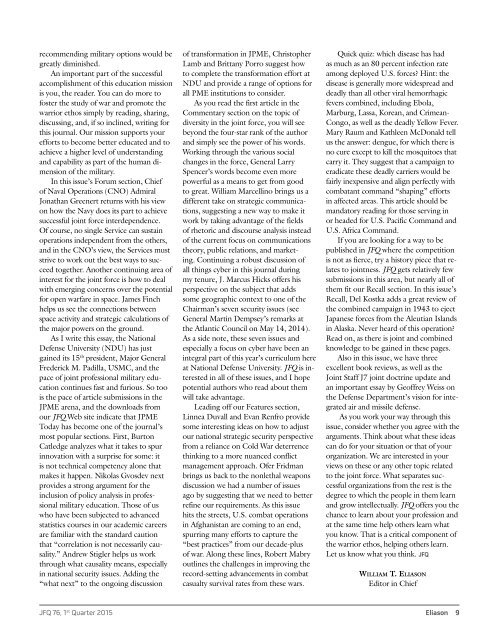jfq-76
jfq-76
jfq-76
Create successful ePaper yourself
Turn your PDF publications into a flip-book with our unique Google optimized e-Paper software.
ecommending military options would be<br />
greatly diminished.<br />
An important part of the successful<br />
accomplishment of this education mission<br />
is you, the reader. You can do more to<br />
foster the study of war and promote the<br />
warrior ethos simply by reading, sharing,<br />
discussing, and, if so inclined, writing for<br />
this journal. Our mission supports your<br />
efforts to become better educated and to<br />
achieve a higher level of understanding<br />
and capability as part of the human dimension<br />
of the military.<br />
In this issue’s Forum section, Chief<br />
of Naval Operations (CNO) Admiral<br />
Jonathan Greenert returns with his view<br />
on how the Navy does its part to achieve<br />
successful joint force interdependence.<br />
Of course, no single Service can sustain<br />
operations independent from the others,<br />
and in the CNO’s view, the Services must<br />
strive to work out the best ways to succeed<br />
together. Another continuing area of<br />
interest for the joint force is how to deal<br />
with emerging concerns over the potential<br />
for open warfare in space. James Finch<br />
helps us see the connections between<br />
space activity and strategic calculations of<br />
the major powers on the ground.<br />
As I write this essay, the National<br />
Defense University (NDU) has just<br />
gained its 15 th president, Major General<br />
Frederick M. Padilla, USMC, and the<br />
pace of joint professional military education<br />
continues fast and furious. So too<br />
is the pace of article submissions in the<br />
JPME arena, and the downloads from<br />
our JFQ Web site indicate that JPME<br />
Today has become one of the journal’s<br />
most popular sections. First, Burton<br />
Catledge analyzes what it takes to spur<br />
innovation with a surprise for some: it<br />
is not technical competency alone that<br />
makes it happen. Nikolas Gvosdev next<br />
provides a strong argument for the<br />
inclusion of policy analysis in professional<br />
military education. Those of us<br />
who have been subjected to advanced<br />
statistics courses in our academic careers<br />
are familiar with the standard caution<br />
that “correlation is not necessarily causality.”<br />
Andrew Stigler helps us work<br />
through what causality means, especially<br />
in national security issues. Adding the<br />
“what next” to the ongoing discussion<br />
of transformation in JPME, Christopher<br />
Lamb and Brittany Porro suggest how<br />
to complete the transformation effort at<br />
NDU and provide a range of options for<br />
all PME institutions to consider.<br />
As you read the first article in the<br />
Commentary section on the topic of<br />
diversity in the joint force, you will see<br />
beyond the four-star rank of the author<br />
and simply see the power of his words.<br />
Working through the various social<br />
changes in the force, General Larry<br />
Spencer’s words become even more<br />
powerful as a means to get from good<br />
to great. William Marcellino brings us a<br />
different take on strategic communications,<br />
suggesting a new way to make it<br />
work by taking advantage of the fields<br />
of rhetoric and discourse analysis instead<br />
of the current focus on communications<br />
theory, public relations, and marketing.<br />
Continuing a robust discussion of<br />
all things cyber in this journal during<br />
my tenure, J. Marcus Hicks offers his<br />
perspective on the subject that adds<br />
some geographic context to one of the<br />
Chairman’s seven security issues (see<br />
General Martin Dempsey’s remarks at<br />
the Atlantic Council on May 14, 2014).<br />
As a side note, these seven issues and<br />
especially a focus on cyber have been an<br />
integral part of this year’s curriculum here<br />
at National Defense University. JFQ is interested<br />
in all of these issues, and I hope<br />
potential authors who read about them<br />
will take advantage.<br />
Leading off our Features section,<br />
Linnea Duvall and Evan Renfro provide<br />
some interesting ideas on how to adjust<br />
our national strategic security perspective<br />
from a reliance on Cold War deterrence<br />
thinking to a more nuanced conflict<br />
management approach. Ofer Fridman<br />
brings us back to the nonlethal weapons<br />
discussion we had a number of issues<br />
ago by suggesting that we need to better<br />
refine our requirements. As this issue<br />
hits the streets, U.S. combat operations<br />
in Afghanistan are coming to an end,<br />
spurring many efforts to capture the<br />
“best practices” from our decade-plus<br />
of war. Along these lines, Robert Mabry<br />
outlines the challenges in improving the<br />
record-setting advancements in combat<br />
casualty survival rates from these wars.<br />
Quick quiz: which disease has had<br />
as much as an 80 percent infection rate<br />
among deployed U.S. forces? Hint: the<br />
disease is generally more widespread and<br />
deadly than all other viral hemorrhagic<br />
fevers combined, including Ebola,<br />
Marburg, Lassa, Korean, and Crimean-<br />
Congo, as well as the deadly Yellow Fever.<br />
Mary Raum and Kathleen McDonald tell<br />
us the answer: dengue, for which there is<br />
no cure except to kill the mosquitoes that<br />
carry it. They suggest that a campaign to<br />
eradicate these deadly carriers would be<br />
fairly inexpensive and align perfectly with<br />
combatant command “shaping” efforts<br />
in affected areas. This article should be<br />
mandatory reading for those serving in<br />
or headed for U.S. Pacific Command and<br />
U.S. Africa Command.<br />
If you are looking for a way to be<br />
published in JFQ where the competition<br />
is not as fierce, try a history piece that relates<br />
to jointness. JFQ gets relatively few<br />
submissions in this area, but nearly all of<br />
them fit our Recall section. In this issue’s<br />
Recall, Del Kostka adds a great review of<br />
the combined campaign in 1943 to eject<br />
Japanese forces from the Aleutian Islands<br />
in Alaska. Never heard of this operation?<br />
Read on, as there is joint and combined<br />
knowledge to be gained in these pages.<br />
Also in this issue, we have three<br />
excellent book reviews, as well as the<br />
Joint Staff J7 joint doctrine update and<br />
an important essay by Geoffrey Weiss on<br />
the Defense Department’s vision for integrated<br />
air and missile defense.<br />
As you work your way through this<br />
issue, consider whether you agree with the<br />
arguments. Think about what these ideas<br />
can do for your situation or that of your<br />
organization. We are interested in your<br />
views on these or any other topic related<br />
to the joint force. What separates successful<br />
organizations from the rest is the<br />
degree to which the people in them learn<br />
and grow intellectually. JFQ offers you the<br />
chance to learn about your profession and<br />
at the same time help others learn what<br />
you know. That is a critical component of<br />
the warrior ethos, helping others learn.<br />
Let us know what you think. JFQ<br />
William T. Eliason<br />
Editor in Chief<br />
JFQ <strong>76</strong>, 1 st Quarter 2015 Eliason 9




